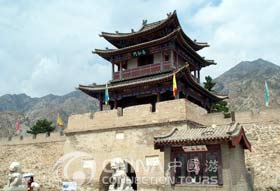
 Meidai Lamasery, lying in Tumd Right Banner at the southern foot of Daqing Mountain, was built by Longqing Emperor Altan khan, chief of Tumd Mongolian Tribe of the Ming Dynasty. The Lamasery is, in fact, the combination of a town and a temple. It is some 50 km away from Baotou City. In the region of Longqing, Altan khan accepted the bestowed title of "Prince of Shunyi," he built the town and the temple. In 1575, the first town and temple was completed, and the royal court bestowed name of Fu'hua. In 1606, the missionary named Maidalihutukertu came to do missionary work here, so it is also called Maidali temple with a circumference of 681 meters, and has an area of 400,000 sq. meters. Clay combined with stones forms the wall of the city, the total length of which is 681 meters, forms a rectangle shape. There had been a sandalwood pagoda, it was said the ash of the Altan Khan's gracious Sanniangzi was kept there. At the four corners of the walls are built the mounds extending out 11 meters, with a watchtower standing on each of them. The layout of Meidai Lamasery serves for three purposes: prince's palace, temple for enshrining and worshiping Buddha, and castle. This is of great value to the study of the Mongolian history and architecture of the Ming Dynasty.
Meidai Lamasery, lying in Tumd Right Banner at the southern foot of Daqing Mountain, was built by Longqing Emperor Altan khan, chief of Tumd Mongolian Tribe of the Ming Dynasty. The Lamasery is, in fact, the combination of a town and a temple. It is some 50 km away from Baotou City. In the region of Longqing, Altan khan accepted the bestowed title of "Prince of Shunyi," he built the town and the temple. In 1575, the first town and temple was completed, and the royal court bestowed name of Fu'hua. In 1606, the missionary named Maidalihutukertu came to do missionary work here, so it is also called Maidali temple with a circumference of 681 meters, and has an area of 400,000 sq. meters. Clay combined with stones forms the wall of the city, the total length of which is 681 meters, forms a rectangle shape. There had been a sandalwood pagoda, it was said the ash of the Altan Khan's gracious Sanniangzi was kept there. At the four corners of the walls are built the mounds extending out 11 meters, with a watchtower standing on each of them. The layout of Meidai Lamasery serves for three purposes: prince's palace, temple for enshrining and worshiping Buddha, and castle. This is of great value to the study of the Mongolian history and architecture of the Ming Dynasty.
It is the only city site of the Darning Jin State that could be found through historical records and real evidence. This was also the place where Alatan introduced the Tibetan Buddhism into Inner Mongolia. The Meidai Lamasery is a symbol of the unity of various nationalities and a key historical relic protected by the state.

